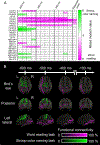Dynamic functional connectivity in verbal cognitive control and word reading
- PMID: 39322094
- PMCID: PMC11500755
- DOI: 10.1016/j.neuroimage.2024.120863
Dynamic functional connectivity in verbal cognitive control and word reading
Abstract
Cognitive control processes enable the suppression of automatic behaviors and the initiation of appropriate responses. The Stroop color naming task serves as a benchmark paradigm for understanding the neurobiological model of verbal cognitive control. Previous research indicates a predominant engagement of the prefrontal and premotor cortex during the Stroop task compared to reading. We aim to further this understanding by creating a dynamic atlas of task-preferential modulations of functional connectivity through white matter. Patients undertook word-reading and Stroop tasks during intracranial EEG recording. We quantified task-related high-gamma amplitude modulations at 547 nonepileptic electrode sites, and a mixed model analysis identified regions and timeframes where these amplitudes differed between tasks. We then visualized white matter pathways with task-preferential functional connectivity enhancements at given moments. Word reading, compared to the Stroop task, exhibited enhanced functional connectivity in inter- and intra-hemispheric white matter pathways from the left occipital-temporal region 350-600 ms before response, including the posterior callosal fibers as well as the left vertical occipital, inferior longitudinal, inferior fronto-occipital, and arcuate fasciculi. The Stroop task showed enhanced functional connectivity in the pathways from the left middle-frontal pre-central gyri, involving the left frontal u-fibers and anterior callosal fibers. Automatic word reading largely utilizes the left occipital-temporal cortices and associated white matter tracts. Verbal cognitive control predominantly involves the left middle frontal and precentral gyri and its connected pathways. Our dynamic tractography atlases may serve as a novel resource providing insights into the unique neural dynamics and pathways of automatic reading and verbal cognitive control.
Keywords: Dynamic tractography; Executive function; Functional brain mapping; Language; Pediatric epilepsy surgery; Physiological high-frequency oscillation (HFO).
Copyright © 2024 The Author(s). Published by Elsevier Inc. All rights reserved.
Conflict of interest statement
Declaration of competing interest None.
Figures





References
MeSH terms
Grants and funding
LinkOut - more resources
Full Text Sources

